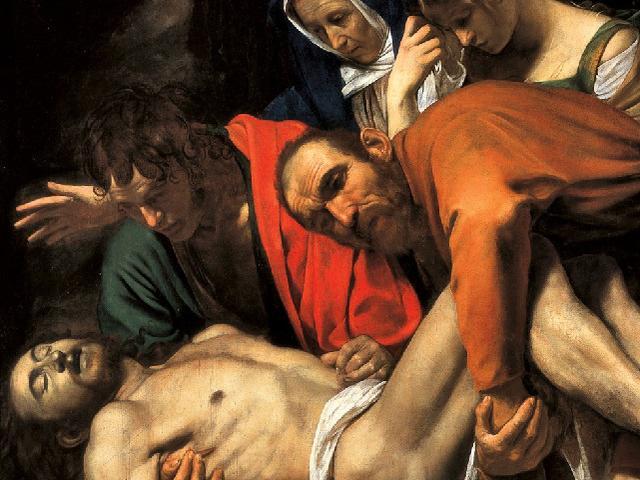The Descent from the Cross

Caravaggio's "The Descent from the Cross" is a stunning masterpiece that captures a pivotal moment in Christian theology with unparalleled drama and emotion. Commissioned by Girolamo Vittrice for the family chapel in Santa Maria in Vallicella in Rome, this painting deviates from the traditional representation of Christ's burial. Instead of depicting Christ being lowered into the tomb, Caravaggio portrays the moment when Christ is placed on the Stone of Anointing by Nicodemus and John, surrounded by the Virgin, Mary Magdalene, John, Nicodemus, and Mary of Cleopas. The figures are arranged in a circular composition, with Christ's outstretched arms and upward gaze creating a sense of intense dramatic tension.
As our gaze descends from the darkness of the painting, we are drawn into the mourning scene unfolding before us. Mary of Cleopas expresses a dramatic lamentation, while the Virgin Mary embodies a more contained emotion. The painting is a powerful portrayal of grief and loss, with each figure conveying a unique response to the tragedy of Christ's death. Caravaggio's skillful use of light and shadow enhances the emotional impact of the scene, creating a sense of depth and realism that draws the viewer in.
One of the remarkable aspects of "The Descent from the Cross" is its universal acclaim among critics and art enthusiasts of Caravaggio's time. The painting was praised for its emotional intensity, masterful composition, and innovative approach to religious subject matter. Even today, the work continues to captivate viewers with its raw emotion and profound spiritual resonance. The influence of Caravaggio's "The Descent from the Cross" can be seen in the numerous copies and adaptations created by other artists, including the renowned Flemish painter Rubens.
In addition to its artistic significance, "The Descent from the Cross" offers a unique insight into Caravaggio's distinctive style and technique. The artist's use of chiaroscuro, or the contrast between light and dark, creates a sense of drama and intensity that is characteristic of his work. The detailed rendering of the figures' expressions and gestures adds to the emotional impact of the painting, inviting viewers to contemplate the profound mysteries of faith and redemption. Through his masterful portrayal of this sacred moment, Caravaggio invites us to reflect on the timeless themes of suffering, sacrifice, and salvation.
© ChatGPT 3.5
*Although Caravaggio did not study anything related to painting, his art revolutionized the discipline.
*Unlike the Spanish representations of the time, the Italian Christs generally die without blood, and collapse in a geometrically challenging manifestation, aspects very marked in the Descent from the Cross.
*This painting was one of the few works produced by Caravaggio that obtained unanimous consensus, since in general, his paintings caused great controversy due to how crude and even violent they were for society.
*Of all Caravaggio's paintings, this is undoubtedly the most monumental, so much so that a few years later it was copied by Rubens and said copy is exhibited in the National Gallery of Canada.
*In 2011, the Prado Museum exhibited Caravaggio's original in its facilities for two months, all on the occasion of the long-awaited visit of Benedict XVI to the city of Madrid and thanks to an exceptional loan agreement with the Vatican Museums.